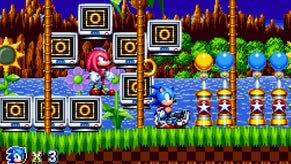Is Sonic Mania the sequel we've waited decades for?
Retro Engine developers take Sega's mascot back to his 2D roots.
Digital Foundry writing about a Sonic game? That's right - with the announcement of Sonic Mania this past weekend, we really wanted to take a look at it. On the surface, Sonic Mania looks like another attempt at bringing Sonic back to his 2D roots but this project has a secret weapon that stand to make a big difference. It's one thing to adopt the same perspective of the Mega Drive classics, as we've seen in Sonic the Hedgehog 4, but it's another thing entirely to capture the gameplay, style, and attitude of classic Sonic. That's the key to a successful Sonic revival and all the signs suggest that this is what Sonic Mania is set to deliver.
The new title is a collaboration between Sega, Christian Whitehead, Headcannon, and PagodaWest games. If you aren't familiar with these names, we wouldn't blame you, but they tie back into the re-emergence of classic Sonic games on multiple platforms, including Sonic CD and the first two 16-bit adventures. It's not the fact that these ports exist that makes them so important in this situation, rather, it's the way in which they were achieved.
It all stems from Christian's long history with the series that is rooted in an almost decade-old fan game he created known as Retro-Sonic. Often known by his handle The Taxman, Christian started off working in Multimedia Fusion before writing and re-writing new code designed to closely simulate Sonic the Hedgehog. This experience ultimately led to a proper, self-developed toolset which helped him study and recreate the original Sonic CD using a brand new custom designed engine dubbed the Retro Engine.
This port of Sonic CD has its differences but is ultimately very faithful to the original game. The momentum, friction, and acceleration of the title character all feel just right. While companies such as Dimps have produced plenty of side-scrolling Sonic games over the years, they never managed to capture the sense of control the original creations offered - something which Christian's work absolutely does.
Sonic CD was ported to mobile platforms and home consoles and was met with a very positive reception by adhering to the original games while introducing 16:9 widescreen support, performance enhancements, and extra features. Its success lead to more enhanced releases. Christian teamed up with Simon Thomley, known as Stealth in the Sonic community, to remake Sonic the Hedgehog and Sonic the Hedgehog 2 for mobile devices. These versions included many of the same features as Sonic CD but expanded upon them in a number of ways, even going so far as to re-create the fabled Hidden Palace Zone in Sonic the Hedgehog 2 - a zone which had received preview coverage prior to release but was ultimately not present in the original release.
Since then, the two have been relatively quiet, aside from teasing Sonic 3 for mobile, but Christian Whitehead and Simon Thomley, who individually founded Headcannon, are back. These two talented programmers, among others, have finally demonstrated what they've been working on with Sonic Mania. It's a return to classic Sonic gameplay with new and remixed levels and it's their aforementioned experience that has us genuinely excited to see where the project goes.
While we certainly have faith that Sonic will play properly, it's also the look and style that play a significant role here. Sonic Mania isn't just another attempt to cash in on 8-bit pixel art nostalgia. Instead, the team has created something here that looks more like a long lost 32-bit iteration of Sonic. It's a game that answers the question "What would a 2D Sonic game have looked like on Sega Saturn?".

While we have no direct confirmation that Sonic Mania is being created using the Retro Engine, it does share many of its hallmarks. It's an engine designed with an old-school bent, focusing more on scaling, rotation, parallax scrolling, raster effects, and more. We did spot some cool wireframe visuals in one of the off-screen videos, however, suggesting a further evolution of the technology.
It's also interesting to look at how the game stacks up against the original 16-bit games. While it's presented in widescreen, the art appears to be drawn at 424x240 - not far off from the 4:3 320x224 of the original games. Beyond that, when looking at Green Hill Zone, it's fascinating to note that many of the tiles have been redrawn and improved while still retaining the original look.
This ties directly into another important element - the sense of style. Sonic is deeply rooted in bright colors, an idealistic 90s take on the future and up-beat music. It's an iconic look and feel that was left behind as Sonic grew up. As the 90s drew to a close, it only made sense for Sega to move into full 3D with a new look, but in many way, it feels as if the series lost its way since then and Sonic Mania is clearly being designed to recapture that magic. The original music created for the game even sounds like something we might have expected in a proper sequel to Sonic CD.
Ultimately, there isn't a lot more we can say right now with so little footage available but we feel this is the single most exciting Sonic project to come down the pipeline in decades. In some respects, one might even suggest that the team working on Sonic Mania understands Sonic better than the Sonic Team of today - and it shows in their lengthy resume. In today's world, this is exactly the kind of uplifting fun that we need and we can't wait to see more.










